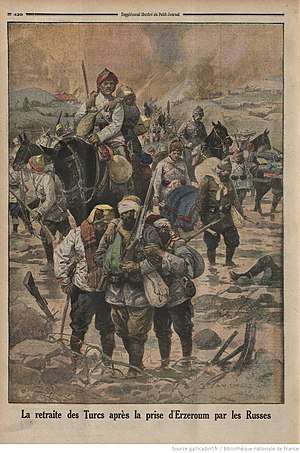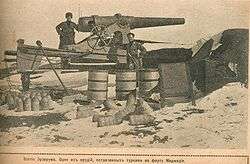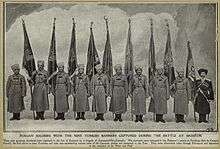Erzurum Offensive
The Erzurum Offensive (Russian: Эрзурумское сражение Erzurumskoe srazhenie, Turkish: Erzurum Taarruzu) or Battle of Erzurum (Turkish: Erzurum Muharebesi) was a major winter offensive by the Imperial Russian Army on the Caucasus Campaign, during the First World War that led to the capture of the strategic city of Erzurum.
| Erzurum Offensive | |||||||
|---|---|---|---|---|---|---|---|
 Le Petit Journal Feb 27 1916 Retreat of the Turks after Erzeroum | |||||||
| |||||||
| Belligerents | |||||||
|
|
| ||||||
| Commanders and leaders | |||||||
|
|
| ||||||
| Strength | |||||||
|
Russian Caucasus Army 290,000 infantry 35,000 cavalry 150 trucks 20 planes |
Third Army 126,000 | ||||||
| Casualties and losses | |||||||
| 21,000 | 35,000 | ||||||
The Ottoman forces, in winter quarters, suffered a series of unexpected reverses, which led to a Russian victory.
Background
After the defeat at the Battle of Sarikamish, the Ottomans tried to reorganise. The Armenian Genocide made supplying their forces a problem.[1] Trade by Armenians, which had supplied the Ottoman Army, was disrupted.[1] The dismissal of Armenian soldiers into labor battalions and their massacres further worsened the problem.[1] However, throughout 1915, the northern sectors of the front remained quiet.
At the same time, the end of the Gallipoli Campaign would free up considerable Turkish soldiers, which made Nikolai Yudenich, the commander of the Russian Caucasus Army, prepare to launch an offensive. He hoped to take the main fortress of Erzurum in the area, followed by Trabzon. That would be was a difficult campaign since Erzurum was protected by a number of forts in the mountains.[1]
Eight of the available Ottoman divisions were designated for the Caucasus Front. Yudenich believed thar he could launch an offensive before the divisions could be ready for battle.[1]
Forces
Russian
The Russians had 130,000 infantry and 35,000 cavalry. They also had 160,000 troops in reserve, 150 supply trucks and 20 planes of the Siberian Air Squadron.[1]
Ottoman
The Ottoman High Command failed to make up its losses from 1915. The war in Gallipoli was using all of its resources and manpower. The IX, X and XI Corps could not be reinforced, and the 1st and 5th Expeditionary Forces were deployed to Mesopotamia Campaign which did not show signs of ending soon. The Ottoman High Command recognised the dire situation on other fronts and do decided that the region was of secondary importance. As of January 1916, Ottoman forces were 126,000 men, only 50,539 of whom were combat soldiers. There were 74,057 rifles, 77 machine guns and 180 pieces of artillery. Many of the guns that were supposed to defend the city had been moved to Gallipoli to counter the British forces. The guns still in the region were older weapons and not in very good condition.
Soldiers were not in poor condition and suffered from inadequate food as was typical of many of the time's Ottomam soldiers. Ottoman forces in the Caucasus Campaign were large on paper but not on the ground. Another source claims that 78,000 troops were in the region,[1] perhaps associating the number of rifles to actual soldiers.
Operations
The Ottoman High Command did not expect any Russian operations during winter. Mahmut Kamil was in Istanbul, and his chief of staff, Colonel Felix Guse, was in Germany. General Yudenich launched a major winter offensive. In mid-January, there was heavy snow, which often came up to 4 feet.
Defense lines

The Russians had a slight edge in numbers but could not rely on numbers alone. For that reason, the Russian plan was to break through a weak part of the line.[2]
On January 10, the initial offensive was directed at the XI Corps. The first engagement was at the Azkani village and its mountain crest of Kara Urgan. In four days, the Russians managed to break through the XI Corps, whose losses were high.
On January 17, at Battle of Koprukoy The forces at Köprüköy, the main town on the road to Erzurum, were forced to leave. By 18 January, the Russian forces approached Hasankale, a town on the road to Erzurum and the new location of the Third Army headquarters. on January 23 Kargabazar Dag Hinis. Within a week, the defensive formation was dissolved.
On January 29, Mahmut Kamil Paşa returned from Istanbul. He could feel that the Russians would not only attack Erzurum but also renew the offensive southern flank around Lake Van. Hınıs, to the south, was taken on February 7 to prevent reinforcements from Muş from coming in.[2] Mahmut Kamil tried to strengthen the defensive lines. That drew most of the Ottoman reserves and diverted their attention away from the decisive attack farther north. On the same day, Russian forces captured Muş after the Battle of Mush, 70 mi from Erzurum.
On February 11 and 12th, the Deve-Boyun Ridge, an important artillery platform, was the scene of heavy fighting. North of the Deve Boyun ridge, the Russian columns approached over the Kargapazar ridge, which the Ottomans had considered impassable. The X Corps guarded that sector of the line, and its commander had positioned his divisions so that they could not support one another.[2] Mahmut Kamil had five divisions in the Deve-Boyun ridge area but was slow to react to events north of that position.
City of Erzurum
The fortress was under Russian threat, both from north and east. With the victories, the Russian Army had cleared the approaches to Erzurum. The Russians were now planning to take Erzurum, a heavily-fortified stronghold. Erzurum was considered as the second best-defended town in the Ottoman Empire. The fortress was defended by 235 pieces of artillery. Its fortifications covered the city on a 180° arc in two rings. There were eleven forts and batteries covering the central area.[2] The flanks were guarded by a group of two forts on each flank. The Ottoman Third Army lacked the soldiers to adequately man the perimeter.[2] Also, casualties totaled 10,000 and an additional 5,000 had been taken prisoner, 16 pieces of artillery had been lost and 40,000 men had found refuge in fortress.
On February 11, the Russians began to shell the fortified formations around Erzurum. Fierce fighting erupted. Ottoman battalions of 350 men had to defend against Russian battalions of 1,000 men. There were few reinforcements for the beleaguered Ottomans. In three days, the Russians had managed to reach the heights overlooking the Erzurum plain. It was now obvious to the Third Army's leaders that the town had been lost. The Ottoman units began to retreat from the fortified zones at the front and to evacuate the town of Erzurum.
On February 12, Fort Kara-gobek was taken. On the 13th, the Russians continued their attacks.
On February 14, Fort Tafet was taken, and the Russians had now penetrated through both rings of the cities's defenses.
By February 15, the remaining forts surrounding Erzurum were evacuated.
Early in the morning of the 16th, Russian Cossacks were among the first to enter the city.[1] Ottoman units had successfully withdrawn and avoided encirclement, but casualties were already high, and 327 pieces of artillery had been lost to the Russians. Support units of the Third Army and around 250 wounded at the town's hospital were taken prisoner.
Although aerial reconnaissance revealed the Ottomans retreat, the Russian pursuit was not effective as it could have been.[2] Meanwhile, remnants of the X and XI Corps established another defensive line, 8 km east of Erzurum.
Casualties

The initial phase of the offensive, known as the Battle of Koprukoy, resulted in 20,000 casualties for the Ottomans and 12,000 for the Russians.[3] At the end of the offensive, during the storming of the city of Erzurum itself, the Russians captured some 9 standards, 5,000 prisoners and 327 guns. The Ottomans lost about 10,000 men killed and wounded as well as 5,000 prisoners.[2] Of the Russians, 1,000 were killed, 4,000 wounded and 4,000 affected by frostbite.[1][4]
Aftermath
The Ottoman Empire did not have a chance to enjoy its victory at the Battle of Gallipoli since its loss of Erzurum changed the atmosphere in an instant. The V Corps (consisting of 10th and 13th Divisions) was deployed from Gallipoli. On 27 February, Mahmut Kamil was replaced with Vehip Paşa. The new location of the headquarters became Erzincan. At that time 3rd Army had only 25,500 men, 76 machine guns and 86 pieces of artillery battle ready. As a further result of the Erzurum Campaign, Trabzon fell in April.
In literature
The Battle of Erzurum forms the climax of John Buchan's novel Greenmantle.
References
- Walton, 1984
- Allen & Muratoff
- Allen and Muratoff, page 342.
- Allen and Muratoff, page 363.
Sources
- Walton, Robert (1984). The Fall of Erzerum. Marshall Cavendish Illustrated Encyclopedia of World War I, vol iv. New York: Marshall Cavendish Corporation. pp. 1262–1264. ISBN 0-86307-181-3.
- W.E.D. Allen and Paul Muratoff, Caucasian Battlefields, A History of Wars on the Turco-Caucasian Border, 1828-1921, 351-363. ISBN 0-89839-296-9
External links
| Wikimedia Commons has media related to Erzerum Campaign. |